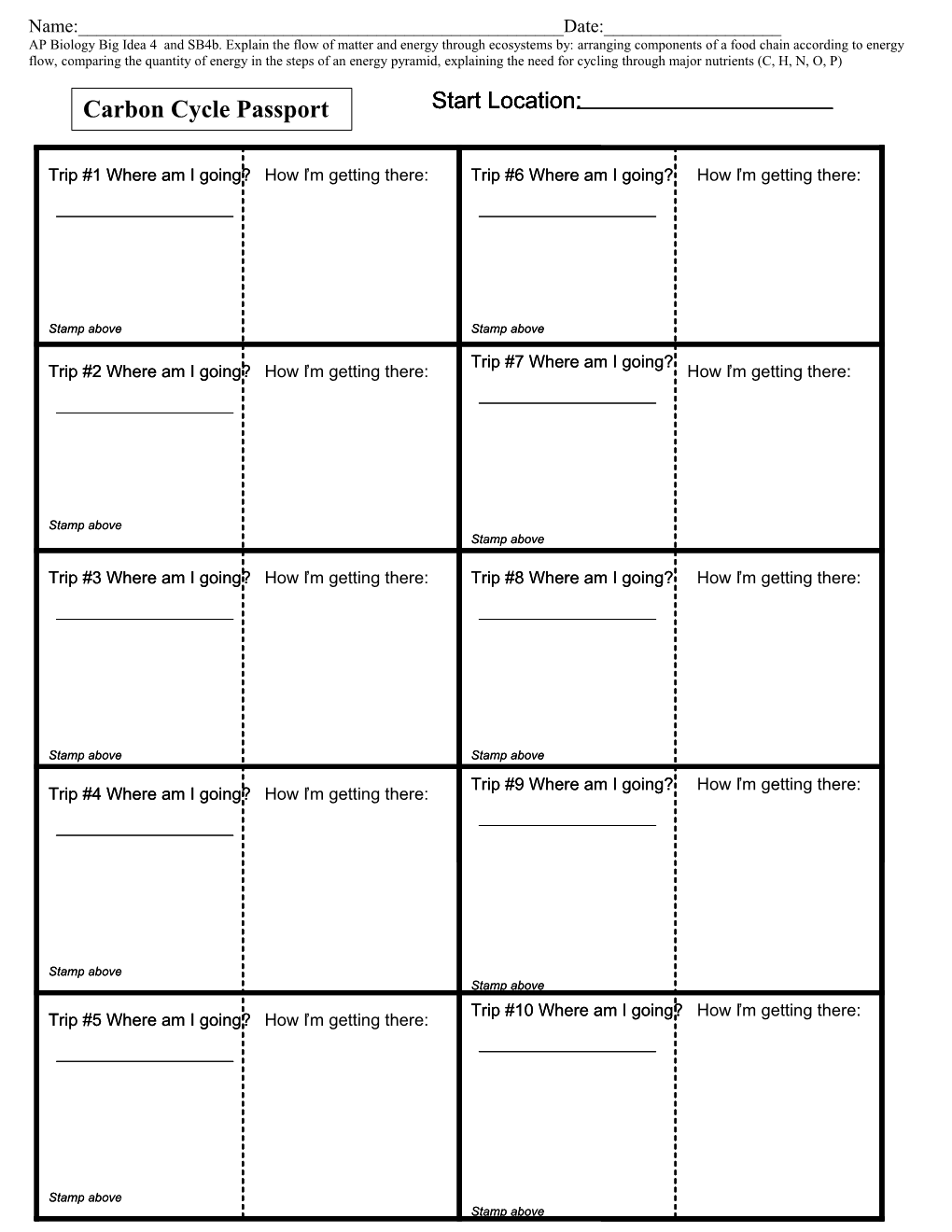Name:______Date:______
AP Biology Big Idea 4 and SB4b. Explain the flow of matter and energy through ecosystems by: arranging components of a food chain according to energy flow, comparing the quantity of energy in the steps of an energy pyramid, explaining the need for cycling through major nutrients (C, H, N, O, P)
Traveling Carbon Lab: The Carbon Cycle
Carbon is an element that is found in both the living portion of our planet and the inorganic parts of the Earth system. The carbon cycle is one of the biogeochemical cycles and is very important for ecosystems. Carbon moves slowly through the cycle and is stored in reservoirs such as the atmosphere, living organisms, soils, and oceans along its way. The purpose of this lab is to play the role of carbon atoms traveling through the carbon cycle and to understand the importance of carbon in ecosystems.
Instructions: 1. Obtain a passport and go to your assigned reservoir. 2. Read the directions at the station and roll the die. 3. Stamp your passport and fill out the “where I’m going” and “how am I getting there” 4. Continue around the room following the directions for your roll of the die.
Questions:
- How many stops can you potentially make on your trip? Did you ever go to the same place more than once?
- Why the movement of carbon is often linked to the cycling of oxygen in ecosystems? Justify your response with examples and think about standard SB3a.
- Explain the niche of decomposers in the cycling of carbon.
- What do you think is the biggest input to carbon in the biosphere? Justify your answer.
- What are two ways that humans can impact the amount of carbon cycling throughout the biosphere?
- What form does carbon take in plants that later supplies energy to animals? (hint: think about the products of photosynthesis/carbohydrates)
- What is global climate change? How do increased quantities of carbon dioxide in the atmosphere may contribute to rising temperatures?
- How can deforestation impact the carbon cycle?
- The amount of carbon in the atmosphere fluctuates in a predictable pattern each year. This pattern is directly caused by autotrophs. Propose a hypothesis for this annual fluctuation in carbon.
- The law of conservation of energy states that energy is neither created nor destroyed? Using one decomposer, one autotroph, and two heterotrophs create a food chain showing how much energy is passed to each organism. What happens to the energy that is not being directly transferred?
- Why is carbon the most important element in terms of living things (macromolecules) and biological processes?
- Create an accurate food chain, using any of the organisms mentioned throughout the stations and label each trophic level with any applicable vocab term. Also show the flow of energy by using arrows properly and indicating the amount of energy found at each trophic level.
Traveling Nitrogen Lab: The Nitrogen Cycle
Nitrogen is an element that is found in both the living portion of our planet and the inorganic parts of the Earth system. The nitrogen cycle is one of the biogeochemical cycles and is very important for ecosystems. Nitrogen moves slowly through the cycle and is stored in reservoirs such as the atmosphere, living organisms, soils, and oceans along its way. The purpose of this lab is to play the role of nitrogen atoms traveling through the nitrogen cycle and to understand the importance of nitrogen to living things.
Questions:
- What are nitrogen fixing bacteria? Where are these bacteria located?
- What is denitrification and how is this process important in ecosystems?
- What would happen if a farmer used too much fertilizer on crops? Explain your answer in terms of runoff and eutrophication.
- What is the difference between nitrification, denitrification, ammonification and nitrogen fixation?
- Read the case study on Hubbard Brook on page 801 in the silver biology book. Explain how deforestation altered the concentration of nitrates in runoff.
- Describe the role of decomposers and detrivores in the nitrogen cycle.
- Livestock farming creates a large amount of animal waste. How would this affect the nitrogen cycle?
- Explain how nitrogen is used to build proteins (recall the four macromolecules).
- Examine the diagram to the right. Summarize the nitrogen cycle. Since there is no “starting” point to these cycles, you can begin your description anywhere!
- Why are nitrogen and phosphorus considered limiting nutrients?
- Explain how phosphorus cycles in an environment? Why is the cycle slower than other biogeochemical cycles?
- Imagine you are at the dinner table and are asked to explain what acid rain is and why it is a problem. Write your response here.
- Draw a diagram that illustrates the water cycle. Do not forget about water loss from plants
- Summarize the diagram below of the general model of nutrient cycling.
- Explain how energy flows in relation to an ecosystem. Why do we care about this?
17. Summarize the diagram above. In terms of chemical cycling and energy flow throughout the biosphere.
- Define the following terms: Gross primary production and Net primary production
- How do light imitations and nutrient limitations impact primary production?
